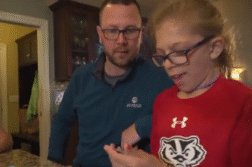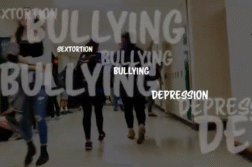ORLANDO, Fla. (Ivanhoe Newswire) — Parents work hard to make sure their child doesn’t fall behind. But when a child is diagnosed with cancer or another life-threatening disease, homework is the last thing on their mind. That’s where a first-of-its-kind PedsAcademy program comes in.
Almost one year ago, ten-year-old August Terry was diagnosed with a bone cancer called Ewing sarcoma. Chemo, radiation, and hospital stays meant going to school was not an option.
August’s mother Wendy Terry said, “It was really devastating to her, as far as not being able to go to school and interact with her peers.”
Thankfully, august is being treated at Nemours Children’s Hospital, which means she got to join PedsAcademy, a first-of-its-kind, in-hospital school with 3D printers, virtual reality, and robots!
August Terry said, “They make like normal school into like fun things.”
There are no boring work sheets. Courses are tailored towards kids’ needs.
Megan Nickels, PhD, Assistant Professor of STEM Education at the University of Central Florida, and Faculty Director of PedsAcademy said, “Those courses are redesigned so that our preservice teachers can understand the medical condition of the child and understand what accommodations need to happen in lesson planning.”
Like eleven-year-old Neal: after suffering a rare stroke, his interest in robots blossomed at PedsAcademy.
Neal Christie said, “Over here, this is what makes it walk.”
He even won the “future engineers” award for his project in the science fair!
And unlike many hospital programs with up to a one to 400 teacher-student ratio …
“We have a 60 to 100 teacher student ratio,” said Nickels.
That means August and Neal get an amazing education, until they’re ready to head home.
PedsAcademy is available free of charge to all children up through collegiate studies, whether they’re in Nemours hospital for days or years. Not only do patients keep up with their peers, nickels says that after their six-month program in robotics, students are a grade advanced in mathematics. Currently there are other hospitals around the country interested in adopting this model in order to have their own PedsAcademy.
Contributors to this news report include: Hayley Hudson, Field Producer; Roque Correa, Videographer; Cyndy McGrath, Supervising Producer; Roque Correa, Editor.
To receive a free weekly e-mail on Medical Breakthroughs from Ivanhoe, sign up at: http://www.ivanhoe.com/ftk
MEDICAL BREAKTHROUGHS
RESEARCH SUMMARY
TOPIC: PEDSACADEMY
REPORT: MB #4607
BACKGROUND: Megan Nickels, PhD, Assistant Professor of STEM Education, University of Central Florida and Faculty Director of PedsAcademy worked as an elementary school teacher before she decided to volunteer at a children’s hospital in Illinois. “I got an immediate phone call back because I had listed that I was a certified teacher and they were very eager to have me come in right away,” Nickels said. She started as a mathematics teacher, following the hospital’s teaching plan. “My first day on the job as it were, I got sent into a room of a 14 year old girl and she had just had a brain tumor removed the day prior and this was my first encounter with a child in that setting at all,” Nickels explained. The room was full of family and noise, with a TV blaring and nurses coming in and out of the room, “Then she’s crying and I was standing there with this math packet of worksheets that they had given me, to work with her with and it in that moment just felt really ridiculous.” Nickels knew there had to be a better way to connect with and teach the children in the hospital.
(Source: Megan Nickels, PhD)
ORIGIN: Nickels thought about how she enjoyed learning as a child: “So I went to Toys R Us and bought a robotics kit, went back the next day, same little girl, and said ‘Do you want to make a robot?’ And she said yes to that.” This led to Nickels pitching the idea of PedsAcademy to Dr. Terry Finkel at Nemours Children’s Hospital in Orlando, Florida. “We have 60 different faculty and students who comprise our PedsAcademy body. So about 25 UCF faculty who come from all different colleges. We have pediatric specialists, physical therapists, psychologists, content area specialists, mathematics exceptional education, and then we have UCF students from many colleges as well,” Nickels said.
(Source: Megan Nickels, PhD)
PEDSACADEMY: Each child is taught based on their needs: “We do a reading and a mathematics baseline assessment in a very playful way. We’re not a paper or pencil test where we want to find out what we know. We have a structure in place to gain a quick snapshot of not only what they know in regards to reading and mathematics and sometimes you catch some other things along the way,” explained Nickels. A recent New York Times article on PedsAcademy said, “PedsAcademy includes lessons in science, literacy, engineering and the humanities. Children don’t get credits from the program, but the lessons offer an opportunity to keep them engaged in learning at a time when it’s easy to do the opposite.”
(Source: https://www.nytimes.com/2019/02/23/education/learning/bulletin-board.html?ref=oembed & Megan Nickels, PhD)
FOR MORE INFORMATION ON THIS REPORT, PLEASE CONTACT:
Yusila Ramirez, Nemours PR
407-650-7676
If this story or any other Ivanhoe story has impacted your life or prompted you or someone you know to seek or change treatments, please let us know by contacting Marjorie Bekaert Thomas at mthomas@ivanhoe.com




